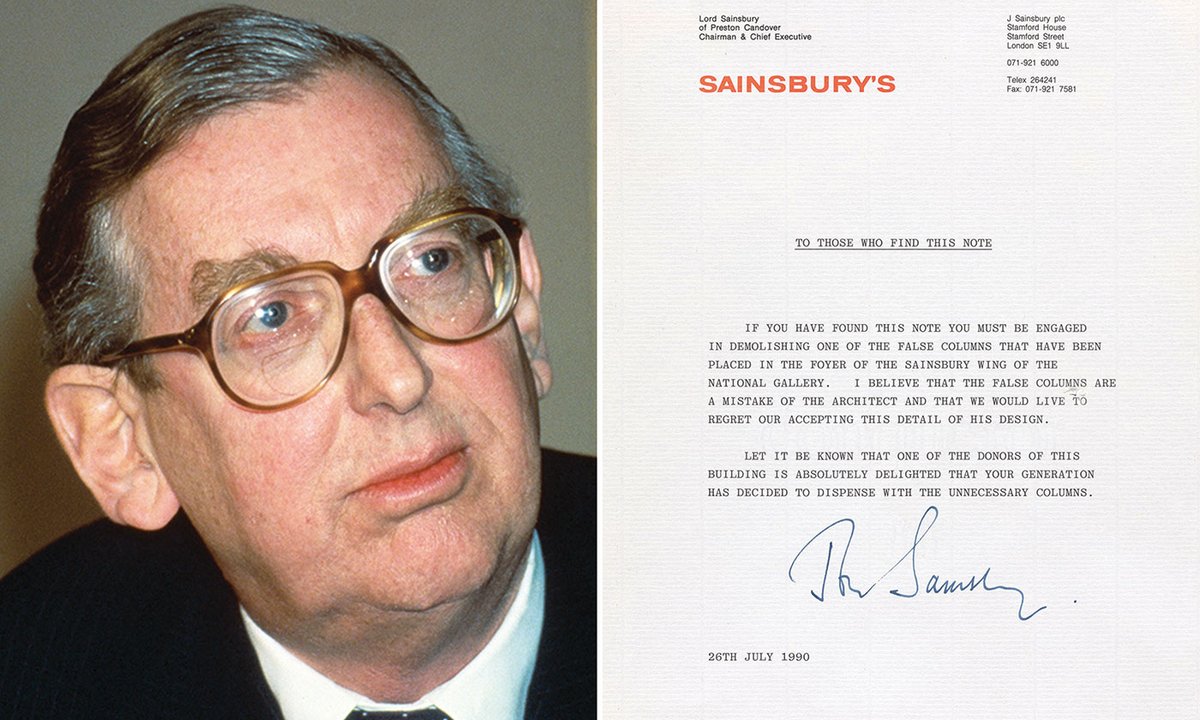Sainsbury Wing contractors find 1990 letter from donor anticipating their demolition of false columns

🌈 Abstract
The article discusses the discovery of a "time capsule" letter written by John Sainsbury, one of the funders of the Sainsbury Wing at the National Gallery in London. The letter criticizes the architects, Robert Venturi and Denise Scott Brown, for including two large false columns in the foyer of the wing, which Sainsbury believed was a mistake. The article also covers the recent renovation of the Sainsbury Wing, which included the demolition of these columns, and the reactions from the architects and the Sainsbury family.
🙋 Q&A
[01] The Discovery of the Time Capsule Letter
1. What was discovered in a column in the foyer of the Sainsbury Wing at the National Gallery? A "time capsule" letter written by John Sainsbury, one of the funders of the Sainsbury Wing, was discovered buried in a column in the foyer. The letter criticized the architects for including two large false columns in the foyer.
2. When was the letter written and what did it say? The letter was written in 1990, typed on Sainsbury's supermarket notepaper, and addressed "To those who find this note". It stated that Sainsbury believed the false columns were a "mistake of the architect" and that he would be delighted if the gallery's new plans involved the removal of the unnecessary columns.
3. How was the letter discovered? The letter, protected in a plastic folder, was discovered last year when the foyer was being reconfigured. It had been dropped into a concrete column that was under construction during the building work.
[02] The Sainsbury Family's Involvement and Reaction
1. Who were the main funders of the Sainsbury Wing? The Sainsbury Wing was entirely funded by John Sainsbury and his two brothers, Simon and Timothy Sainsbury, who were descendants of the founder of the Sainsbury's supermarket chain.
2. How did Anya Sainsbury, John's widow, react to the rediscovery of the letter? Anya Sainsbury was present when her husband's note was removed and said she was "so happy for John's letter to be rediscovered after all these years" and felt he would be "relieved and delighted for the gallery's new plans and the extra space they are creating."
3. How much did the Sainsbury family contribute to the recent £85m upgrade of the Sainsbury Wing? The Sainsbury family, through the Linbury Trust (set up by John and Anya) and the Headley Trust (set up by Timothy and his wife Susan), have each committed £5m, representing one of the largest donations to a UK museum in recent years.
[03] The Architectural Controversy
1. What was the architects' (Venturi and Scott Brown) vision for the foyer of the Sainsbury Wing? Venturi wanted the foyer to have the feel of a "mighty crypt," with the extra columns intended to create a sense of weight and an "anticipatory space" leading up to the main galleries.
2. Why did John Sainsbury disagree with the inclusion of the false columns? Sainsbury argued that the extra columns would "conceal the entrance to the lecture theatre and temporary exhibition galleries, confusing the visitor," and that sightlines should be as unencumbered as possible.
3. How did the National Gallery's director, Neil MacGregor, resolve the disagreement between Sainsbury and the architects? MacGregor ultimately concluded in the late 1980s that the false columns were acceptable, as Venturi had a "coherent idea of the organic link between entrance hall, staircase and main galleries," and the gallery should "let the architect be the architect."
[04] The Recent Renovation and Demolition of the Columns
1. What were the main improvements planned for the Sainsbury Wing as part of the recent £85m renovation? The main improvement was to create a more open and welcoming foyer to cope with the increased number of visitors, which included the demolition of the two non-structural columns.
2. How did the Twentieth Century Society react to the planned demolition of the columns? The Twentieth Century Society argued that the columns "contribute to the sense of weight and the lobby's function as an anticipatory space," but the National Gallery disagreed, stating that the columns hindered wayfinding by "restricting views to the lifts and obscuring the entrance to the [lecture] theatre and temporary exhibition spaces."
3. How did Denise Scott Brown, Venturi's partner, respond to the demolition of the columns? Scott Brown vociferously opposed the redesign of the foyer, arguing that the placement of the columns was integral to the "overall vertical layering of the building" and the "sequence of what you saw" in creating an "impactful entry and movement pattern."